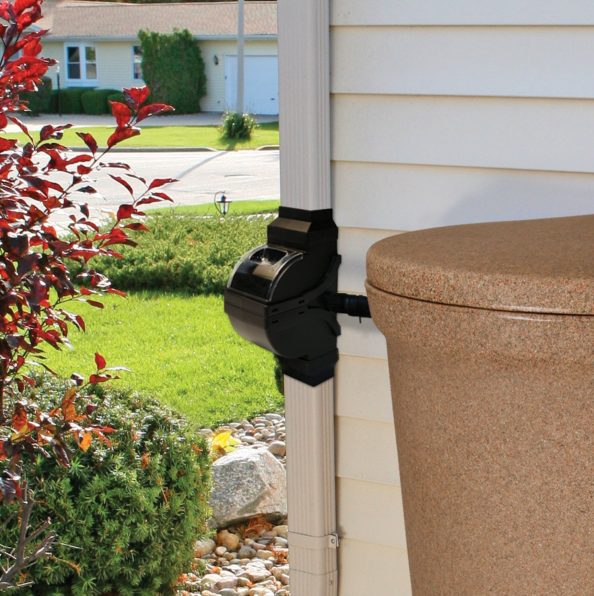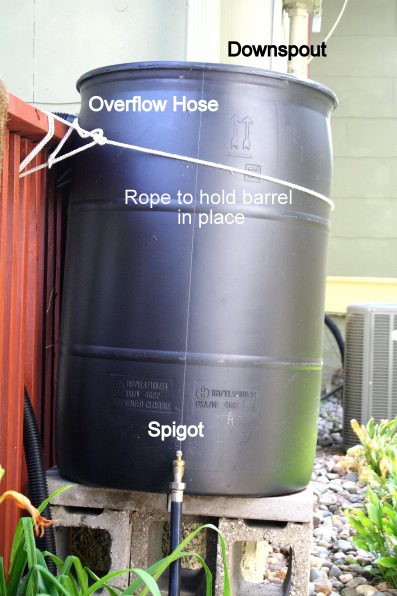Harvesting the rainwater that falls on your house is an excellent way to save money and is good for the environment. You spend so much time and effort on your lawn and landscaping consider adding a rain water harvesting system to compliment all that hard work. Add a rain barrel under a downspout from your roof to begin collecting this simple, free resource.
- What Is a Rain Barrel and What Do I Do with the Water?
- Why is a Rain Barrel Good for the Environment?
- How Can a Ran Barrel Save Me Money?
- What Happens When My Rain Barrel is Full?
- How to Install a Rain Barrel
- What Size of a Rain Barrel Do I Need?
- What are the Benefits of a Rain Water?
- Rain Barrel Maintenance
- What Do I Do With My Rain Barrel in the Winter?
What Is a Rain Barrel and What Do I Do with the Water?
A rain barrel is a small, above ground tank or barrel that is used to collect rainwater from a rooftop downspout or gutter for later use. This water can be used in the garden, lawn, or landscaping. It can also be used for things like washing your car and pets. Rain barrels can help you store water that you can use at a later time when water is in short supply or during water restrictions.
Why is a Rain Barrel Good for the Environment?
Another important reason to consider adding a rain barrel to your yard is that it reduces your environmental footprint. You will use less treated water. This will cut back the amount of water you are sending to the sewage treatment plant which can be an expensive and energy-intensive process.
Collecting your rain will also reduce water run-off which can be a big contributor to erosion and pollution. Water that falls on your property doesn’t all absorb into the ground. Some of it does, but a lot of it will flow over the surface and away from your house. As it flows it picks up sediment, fertilizer, pesticides, and other contaminates which then flow into streams, creeks, rivers, and lakes. These contaminates are not only a problem for waterways, but is also a threat to drinking water.
How Can a Ran Barrel Save Me Money?
Saving your rainwater can save you money. Up to 40% of the averages homeowners’ water bill is spent on outdoor uses. Wouldn’t it be great to save that money? A 500 square feet section of roof feeding into one downspout will produce 300 gallons of rain with a one-inch rain fall. That is a lot of rain going down the sewer that you can using for free.
What Happens When My Rain Barrel is Full?
During the rainy spring your rain barrel may fill up pretty quickly. A 200 square-foot area of roof feeding a 60-gallon barrel will fill up with half an inch of rain. Your rain barrel will have an overflow hose. When the barrel is full of water the extra water will flow through the hose and, depending on where you direct the hose, away from your house. Without an overflow hose, the water will pour out the top of the barrel when it is full. This extra water might not flow away from your house and can instead seep into your foundation or your basement.
Another option would be to install a diverter into your downspout. A diverter is installed into your downspout with a hose connecting it to your barrel. When your barrel is empty the diverter will direct water from the downspout into the barrel. When the barrel is full the back pressure in the hose will redirect the extra water back into the downspout which will then flow down the spout and away from your house.
How to Install a Rain Barrel
Rain barrels are easy to install. There are many rain barrels you can purchase, or you can make your own. If you make your own you’ll want to use a closed container that is opaque. Clear containers will grow mildew and open containers attract mosquitos.
The first thing you’ll want to do is find a location in your yard. Place the barrel under the downspout of your house where you can best take advantage of the rain and where it will be closest to where you’ll be using it.
Be sure the ground you select is firm and level. Rain barrels, when full, are very heavy. You may want to secure the barrel to the side of your house if you live in an area where winds might blow an empty rain barrel away.
Elevate the barrel so that gravity will make water flow through the hose faster to make watering quicker. Unless you have a pump you’ll want the barrel to be elevated above the level of what you are watering. If the barrel is lower, the water won’t flow. You can elevate your barrel by placing it on cinder blocks or buying a specialized rain barrel stand.
The next thing your need to do is install the downspout. If you are making your own barrel you’ll need to cut a hole in the top of the barrel. Only cut a hole big enough for the downspout. If it is too large you’ll collect debris and insects. You may want to add a screen over the opening to keep out debris and insects. The downspout will likely need to be shortened. Shorten the downspout with a hacksaw then add a flexible elbow over the end and feed the elbow into your barrel.
The spigot will go on the bottom of the barrel. Be sure to place it so you can still place a watering can under it. This is another reason to elevate your barrel.
The last thing you’ll need is an overflow hose. This will be on the side of the barrel at the top. When the barrel is full you do not want it to over flow from the top. This overflow will flow back into your home’s foundation and basement. An overflow hose leads extra water through the hose and away from your house.
What Size of a Rain Barrel Do I Need?
To determine how big of a rain barrel or how many barrels you’ll need you’ll want to estimate your outdoor water usage. You can roughly estimate this by timing how long you spend on your watering activities. Time how long it takes your hose to fill one gallon. You can use this to estimate your water flow per minute. If it takes you 15 seconds to fill one gallon your water flow is four gallons per minute. Then, time how long you spend watering and you’ll know how many gallons you use on a weekly or daily basis.
What are the Benefits of a Rain Water?
Rain water is good for your garden, lawn, and soil. It is considered soft water which means it is void of chemicals and minerals. Tap water has been treated and has added chemicals, such as fluoride, and minerals to make it safe for drinking. These added minerals and chemicals can accumulate in your soil over time and may damage plant roots. Rain water can help dilute this buildup.
Rain water is oxygenated which means oxygen is dissolved in the water. This dissolved oxygen is beneficial for bacteria growing in the soil and the aeration of plant roots. This helps your plants grow healthy and strong.
Collecting and saving your rain water is also beneficial if you live in an area that is often dry in the summer. You will have your own source of water when supplies or low or during water restrictions.
Rain barrels can also help control moisture around your foundation. Instead of water seeping into the ground around your house it is stored in a barrel.
Rain Barrel Maintenance
During the summer and before you install your rain barrel be sure to check your gutters and downspouts on a regular basis. By keeping your gutters and downspouts and gutters in good repair you can be sure to harvest every drop of rain water. Make sure there is no debris clogging your gutters or leaks draining the water.
Check your barrel often and if there is any build-up of sediment spray the barrel with a hose. Check for leaks in the hose, or spigot and repair if necessary. Repair any holes you may find in the screen or mesh you may have in the opening on the top. Examine the stand and straps are sturdy and in place. Finally, inspect the overflow hose and be sure it is still flowing away from your house.
What Do I Do With My Rain Barrel in the Winter?
If you live in a part of the country that experiences freezing temperatures or below you’ll need to winterize your barrel before the cold season. The first thing you’ll want to do is to disconnect it from your downspout. Add an extension to the downspout so water will continue to flow away from your house. Use or dump whatever water remains in the barrel then rinse it out to remove any sediment build-up. Open the spigot and let it drain. This will ensure they will not freeze and crack when it gets colder.
If you have indoor storage it is best to store your barrel there. If you need to store it outside turn it upside down. You can cover the barrel with a tarp for extra protection. You may want to tie it up as well so it doesn’t blow away.
Adding a rain barrel to your yard is an easy and inexpensive way to harvest healthy rain water for your plants and to help save money.











No Comments